History > Class Notes > Historical Foundations of South African Law (HFL1501): Practice Exam 2020: Questions and Answers His (All)
Historical Foundations of South African Law (HFL1501): Practice Exam 2020: Questions and Answers Historical Foundations of South African Law (University of South Africa)
Document Content and Description Below
lOMoARcPSD|784381 Practice Exam 2020: Questions and Answers Historical Foundations of South African Law (University of South Africa) ORIGINS QUESTIONS: STUDY UNIT 1 Study Unit 1: 1.1 What i... s the difference between (i) the reception, (ii) the transplantation and (iii) the superposition of a legal system? (3) 1.2 Indicate whether one could rightly speak of (i) a transplantation of Roman Dutch law onto South African soil, and (ii) a reception of human rights law into the South African common law? (2) 1.3 Briefly explain the difference between external and internal legal history. (4) 1.4 What is the difference between (i) reception, (ii) Transplantation and (iii) superimposition of a legal system? Illustrate your answer with examples from South African legal history. 1.5 The South African legal system has three components, namely a Western component, an indigenous component and a universal component. Briefly state what each these three components consist of. (4) 1.6 Explain the meaning of (i) the external history of the law, and (1) (ii) the internal history of the law. (1)= STUDY UNIT 1 (1) The common law is an important source of the Western component of our law. (Keep in mind: In South Africa the term “common law” refers to Roman-Dutch law as influenced by English law. This “common law” is a source or a place of origin of South African law and must be distinguished from other sources such as decisions of the courts, legislation and customary law. In a broader sense “common law” also has another meaning, namely the common law of England. The English common law influenced the legal systems of many countries (eg America, Australia). The legal systems of countries which have been influenced by English law are thus referred to as “common-law systems”. In contrast, the legal system which have been influenced by Roman law are referred to as “civil-law systems”. (2) STUDY UNIT 2 (1) Since South African law has been influenced by the European/Roman/civilian tradition and the English/common-law tradition, as well as the indigenous/African tradition, we may say that our legal system is mixed or hybrid. ( Keep in mind: The Western component of our law comprises both Roman-Dutch law (which has characteristics of the Roman or civilian law which prevailed in Europe until the 19th century) as well as English law (which has characteristics of the English common law which prevails in England). In addition, our law has an African component which comprises the indigenous African law. It is because there are characteristics of all these legal systems in our law, that we may speak of a “hybrid legal system”. ( Keep in mind: The transcription (writing down) of indigenous law has mainly been done by Westerners and these transcriptions are mostly in English (or Afrikaans) and not in an African language. The fact that it had been reduced to writing, does not mean that the natural development of indigenous law has ceased. The law still develops within the indigenous communities and is still orally transmitted from generation to generation. That is why fieldresearch is still done in indigenous communities to establish the extent to which the law has changed. For example, the Centre for Indigenous Law at Unisa, conducted research in Atteridgeville and Mamelodi to determine whether bridewealth (lobolo) still plays a role in modern indigenous marriages. (2) Name any two anthropologists-cum-lawyers who engaged in restatements of pre- colonial indigenous law. (3) The “repugnancy” clause means that indigenous law is only recognised if it is not contrary to Western notions of other words, if it is not repugnant to Western thinking. (4) During the colonial period, the only area of the Cape Colony in which indigenous law was officially applied, was the (5) The first attempt at the codification of indigenous law in Natal was made in 1878 when the was drafted. (6) In the colonial period, the ultimate goal in the administration of justice was the of indigenous law into colonial law. The indigenous communities did not support the imposed (7) In 1927, colonial legislation regarding indigenous law was consolidated in the This Act provided for separate courts for blacks and for the limited recognition of indigenous law. Section 11(1) of this Act contained the notorious “clause. (8) In terms of the Black Administration Act 38 of 1927, limited civil and criminal jurisdiction was granted to the indigenous courts of chiefs and headmen. This Act also instituted commissioners’ courts as an inexpensive means to resolve disputes between blacks. The latter courts were presided over by officials of the Department of Native Affairs who had discretion to apply either i (9) In 1986, the Special Courts for Blacks Abolition Act abolished, amongst others, commissioners’ courts. The Act afforded the (10) As from 1996, section 211(3) of South Africa’s new Constitution provides that all courts must apply indigenous law, when it is applicable. However, indigenous law still remains subject to the. (11) Although the Dutch authorities in the Cape proclaimed the idea of freedom of religion in 1804, Islam was not allowed to flourish. Islamic family law has not enjoyed official recognition by the State. (12) Islamic marriages are today still regarded as contrary to public policy because of their potentially polygynous nature. ( Keep in mind: In 2003 the South African Law Commission published a report on Islamic marriages and related matters. The report contains a draft bill on Islamic marriages. Remember further that the Recognition of Customary Marriages Act came into operation towards the end of 2000 thereby giving full recognition to indigenous African marriages. (13) Ryland v Edros 1997 (2) SA 690 (C) and Amod v Multilateral Motor Vehicle Accidents Fund 1999 (4) SA 1319 (SCA) are two important cases in which the Courts have indicated that they are prepared to reconsider the status of Study Unit 2: 2.1 Name two ways in which traditional objections to the study and teaching ofpreliterate African history and law have been overcome. (2) 2.2 How did the position of African indigenous law in the Transkeian territories during the nineteenth century differ from the position of indigenous law in the Cape colony during the same time? (2) 2.3 How does the position regarding the application of indigenous law set out in section 211(3) of the Constitution differ from the position which was applicable at the beginning of the 1990’s, that is before the Constitution came into operation? (2) 2.4 What was the attitude of the administrators of the interior settlements (the regions outside the Cape) towards the indigenous populations and towards their law during the colonial period? How did Shepstone’s attitude differ from this general attitude? (3) 2.5 Which Act consolidated the colonial legislation regarding indigenous law? (Give the full name and date). Did this Act give full and unlimited recognition to indigenous law? Explain your answer. (2) 2.6 Is the repugnancy clause still applicable today? Explain your answer. 2.7 How has the new Constitution changed the position and status of indigenous law? (3) 2.8 Explain how the current position of indigenous law in the South African legal system differs from the position of Islamic law. (3) 2.9 As a result of their geographical isolation, the Bantu-speakers had a culture without writing that is a pre-literate culture. However, it is possible to reconstruct their history through oral traditions. Explain what is meant by “oral traditions”. (1) 2.10 Would you say that indigenous African law is still oral in nature? Give reasons for your answer. (2) 2.11 Which Act consolidated the diverse colonial legislation in the Union of South Africa in 1927? (1) 2.11 (i) Which indigenous court, established in terms of the legislation mentioned in 3.1 above, is still in operation today? (1) (ii) Which legal system(s) may the court, mentioned in 3.2(i) above, apply? (1) 3.3 Which indigenous court has been abolished? (1) 3.4 Name two ordinary courts that may apply indigenous law today. (2) STUDY UNIT 3 (1) The main source of Roman law is the Corpus Iuris Civilis. (2) The is a code which describes Roman law as it was during the 6th century AD at the end of its development. (3) Critical legal thinking about the ideals which inspire the Western legal tradition originated in (4) Athens was famous for philosophers such as In the 5th century BC, Greece as we know it today, consisted of a number of independent states. For our purposes, the most important was Athens. Thus, Athens in question (3) refers to the State of Athens.) (5) The ideal of a scientific and rational legal system originated in the work The Republic, written by the Greek philosopher (6) Much of what we know about the earliest origins of Roman history is based on (7) Roman legal history may be divided into four phases, namely the era of. ( Keep in mind: Roman political history may be divided into four phases: The Period of the Kings, the Republic, the Principate and the Dominate. There are also four phases in the development of Roman law: the period of early Roman law, the pre-classical, classical and post-classical periods. These phases in the development of Roman law do not necessarily coincide with the phases of the political history. (8) During the period of early Roman law, law was characterised by strictness and rigidity. (9) During the pre-classical period of Roman law the ius gentium was established. This law was characterised by (10) During the first two centuries of the Principate, the power of Rome was at its height and Roman law experienced its greatest development. These two centuries were known as the classical period of Roman law. (11) During the post-classical period, Roman law was simplified and administered by officials in the distant parts of the Empire. This led to the emergence of vulgar Roman law. (12) Towards the end of the post-classical period there was a renewed interest in classical Roman law. (13) During the early period of the kings, Roman law consisted of customary law (14) Traditional indigenous African and early Roman societies were similar. They were both subsistence communities and the emphasis was on group (15) During the Republican period, the three factors which contributed to the growth of Roman customary law into a system which could fulfil the (16) The class struggle between the plebeians and the patricians led to the promulgation of the Law of the Twelve Tables. (17) The Law of the Twelve Tables was important because it led to a division between rules of law and rules of religion. (18) The Law of the Twelve Tables marks the beginning of legal science or jurisprudence in Western legal history. (19) The Law of the Twelve Tables contained (20) The primary task of the praetor urbanus was to administer justice. He appointed a judge to settle disputes in terms of (21) Roman law (the ius civile) was applicable in disputes between Roman citizens. (22) The office of praetor peregrinus was instituted to regulate disputes between . (23) The praetor peregrinus developed new legal rules which were known as the ius gentium. This law differed from the ius civile in that it was less formalistic and less severe/strict and was based on equity/fairness. (24) The praetor urbanus, who dealt with cases between Roman citizens, had the power to (25) The new, fairer, less formalistic law, developed by the praetor urbanus, was known as the ius honorarium. The ius civile was a strict and formalistic law which was applicable in disputes between Roman citizens. The ius gentium was a less formalistic, fairer law which was applicable in disputes between foreigners or foreigners and Roman citizens. The ius honorarium developed when the praetor urbanus developed a new law which was based on the ius civile but influenced by the equitable principles of the ius gentium. This law was applicable in disputes between Roman citizens. As Roman society developed, the ius honorarium was increasingly used in disputes between Roman citizens. It eventually replaced the archaic ius civile. In AD 212, the Emperor Caracalla abolished the distinction between Roman citizens and foreigners. Thus, from early in the 3rd century AD, there was no longer a need to distinguish between the ius civile, ius gentium and ius honorarium. A “new” legal system evolved which was based on the ius gentium and the ius honorarium. (26) The Lex Cornelia de Edictis forbade the praetor to deviate from the edicts (27) The jurists started their work in the Republican period and continued it throughout the Principate. They did their most fruitful work during the Principate. (28) During the Republic, Roman law became more accessible to the people. The jurists were responsible for the publication of Roman law and thus helped in this process. (29) During the Principate the praetor became a pawn in the hands of the emperor. The praetor was elected by the emperor and acted only upon his (30) Gaius was one of the most important jurists of the classical period of Roman law. His work, the Institutiones/Institutes, is one of the few works of (31) The last great jurists of the classical period of Roman law were Papinian, Ulpian, Paul and Modestinus. (32) During the Principate imperial legislation became an important branch of the law. However, this law did not contribute much to the development of legal science. (33) The greatest influences on the development of law during the Principate were the praetor, the emperor and the jurists. (34) During the Dominate a law school was established in Beirut. This school, (35) During the Dominate law consisted mainly of imperial legislation. (36) The Codex Theodosianus was a codification of Roman law which applied in Study Unit 3: 3.1 Name two reasons why Roman law should still be studied today. (2) 3.2 Name four events leading up to Justinian’s codification of Roman law. (4) 3.3 What was the importance of ancient Athens in the development of our legal system? (1) 3.4 Name one Greek philosopher. (1) 3.5 Name the four parts of comprising the Corpus Iuris Civilis. (2) 3.6 Name the most important codification of the Roman law in the West in the early Middle ages. (1) 3.7 What was the influence of the Lex Cornelia de Edictis on the activities of the praetor in Roman times? (1) 3.8 What was the name of Justinian’s chief legal adviser? (1) 3.9 The Corpus Iuris Civilis consists of the Digest, the Codex, the Institutes and the Novellae. Briefly explain what each of these parts comprise of. (4) 3.10 Plato wrote The Republic, which was a book devoted to politics, law and the state. Very briefly, explain what Plato’s recommendations included for the ideal state. (2) 3.11 What was the ius honorarium? How did the ius honorarium develop? (5) 3.12 Briefly distinguish between the following three concepts: ius civile: (1) ius gentium: (1) ius honorarium: (1) 3.13 Write a short note on the office of the Roman praetor and its importance for legal development. (5) STUDY UNIT 4 (1) The Leges Barbarorum were the recorded tribal laws of the Germanic people. (2) The establishment of the Holy Roman Empire by a Germanic king was a result of the “ (3) The “” refers to the Germanic peoples’ admiration of Roman culture, particularly its legal system and ordered government. This contributed to the survival of Roman law after the fall of the Western Roman Empire in the 5th century AD before its revival by the glossators in the 12th century. (4) How did recordings of Germanic law help with the preservation of Roman law? Firstly, , the clerics, who were schooled in Latin and Roman law, drafted these laws and worked Romanist principles into the fabric of the Germanic law. (5) In the early Middle Ages many tribes inhabited Western Europe. It was not desirable to apply one general law to all the different tribes. Thus every person lived according to the law of his or her tribe. This is referred to as (6) With the accumulation of land in the hands of powerful landowners, people living within a specific feudal territory became subject to the law of that area. This is known as (7) The Germanic peoples’ records of their own tribal laws were known as the (8) The survival of Roman law in the West after the fall of the Roman empire (5th to 11th centuries AD) was due, in part, to the “barbarian’s” codifications of Roman law. These codifications were called the Leges (9) An important factor in the survival of Roman law after the fall of the Roman empire (5th to 11th centuries AD) was the Church. The expansion of the Christian religion was largely due to the granting of freedom of religion to the Christians by the Emperor Constantine. The church was governed by Roman law. (10) Between the 5th and the 12th centuries AD two of the sources of Roman law used by the Church were the Visigothorum and the Corpus Iuris Civilis. During this period the law of the Church had not yet reached the stage at which it could be regarded as a separate legal system. (11) The Collectio Dionysiana is an important collection of church laws which was compiled duringthe 6th century AD. (12) The law of the Church of the early Middle Ages laid the foundation for the development of a separate system of church law namely canon law. Keep in mind: The missionaries that came to South and Southern Africa did not bring canon law toSouth Africa. Canon law became part of South African law through the Roman-Dutch law. (13) With the death of Charlemagne, Europe entered a time of cultural and economic stagnation and (14) The Libri Feudorum is the best-known recording of feudal law which, during the Middle Ages, formed part of Study Unit 4: 4.1 What is canon law? Name two reasons why canon law is important to the history of the South African law. (3) 1. 4.3 Write brief notes on the personality principle and the Leges Romanorum (Leges Romanae Barbarorum). (3) 4.4 Give one example of such a Lex Romana Barbarorum. (1) 4.5 How did the above-mentioned lex help to preserve Roman law in the West before the 12th century? (2) 4.6 Name one similarity between Roman and traditional African societies. (1) 4.7 Write short note on canon law: what is canon law and how has it influenced South African law? (4) 4.8 What was the influence of canon law on secular law (Roman law)? (1) 4.9 Explain the role of the Roman Catholic Church in the survival of Roman law in the West during the Early Middle Ages (5th century AD to 11th century AD). (2) STUDY UNIT 5 (1) The South African Law Association refers to countries in Southern Africa whose legal systems consist of (2) The glossator, Vacarius, founded the law school at Oxford in England. (3) The beginning of the 12th century marked the period of the revival or renewal of Roman law. This revival took the form of (4) The glossators followed an exegetical method in their study of the Corpus Iuris Civilis. This means that they analysed the text, tried to (5) In their study, the glossators first concentrated on understanding the manuscript of the Corpus Iuris Civilis and then wrote (6) The notes that the glossators wrote in the margin of the text and between the lines of the Corpus Iuris Civilis were called glosses and that is why these scholars were called glossators. (7) The importance of the glossators’ analysis of the text of the Corpus Iuris Civilis brought to light the (8) The three most important glossators were. (9) Irnerius was generally recognised as the father of the glossators. Vacarius was also known as the Bolognese “missionary” because he spread “glossatorial gospel” to England. (10) The Glossa Ordinaria was a collection of glosses compiled by Accursius (11) The work of the glossators is significant for three reasons: They carried out an efficient Keep in mind: Question (11) deals with the importance of the work of the glossators for general legal development. Question (7) indicates the importance of the specific technique they followed in their study of the Corpus Iuris Civilis. (12) The glossators’ work was criticised because it was not systematic, lacked historical. (13) The Decretum Gratiani, which was a collection of canon law sources as well as a textbook for students, was published in the 12th century by Gratianus. (14) The Corpus Iuris Canonici consisted of the Decretum Gratiani and other (15) The Corpus Iuris Canonici was a (16) The jurists who studied the Corpus Iuris Canonici were known as the (17) The ultramontani were a group of jurists at the French law school of Orléans. (18) Unlike the glossators, who followed an exegetical approach in their study of the Corpus Iuris Civilis, the ultramontani adopted a (19) The ultramontani’s goal was to (20) Revigny and Bellaperche were the two most important ultramontani. (21) The ultramontani was the first group of jurists to work out rules for the reception of (22) According to Revigny and Bellaperche, canon law and Roman law had (23) From the middle of the 12th century, canon law had a strong influence in France, particularly in the French (24) The commentators or post-glossators were much more concerned with the practical aspects of the law than with (25) The approach of the commentators was to interpret the glosses on the Corpus Iuris Civilis and the text itself. This meant that each (26) The commentators took up the challenge of reconciling the contradictions that arose between Roman law and the rules of (27) The commentators are also known as the (28) Name two of the most important commentators or post-glossators. (29) The commentator Bartolus is regarded as the greatest medieval jurist. (30) The commentators laid the foundation for the 17th century school of natural law. (31) The commentator Bartolus laid the foundation for modern (32) The commentators’ influence on the development of the law was not confined to Bologna in Italy.It spread to most parts of Western Europe and played a major role in the creation of the (33) The commentators facilitated the importation of Roman law into the practical administration of justice and it was their influence combined with the invention of printing (34) According to the commentators, Roman law and canon law should be kept separate. They argued that canon law had to be applied instead of Roman law: in matters of a purely spiritual nature, in matters concerning the church and in those cases where the application of Roman law would amount to sin. (35) The European common law or the ius commune came into being when Roman law and canon law were received into the Germanic customary legal systems. Study Unit 5: 5.1 Write a short note on the glossators. Refer to 5.2 Name two reasons for the so-called revival of Roman law in the 12th centuryAD. (2) 5.3 Briefly explain the ultramontani’s rules with regard to the application of Canon law in secular law. (2) 5.4 How did the commentators further develop these rules of the ultramontani? (3) 5.5 What did the European ius commune consist of? How did this common law come into being? (2) 5.6 What did the European ius commune consist of? (1) 5.7 Explain what is meant by the European ius commune. (1) 5.8 In which instances may the South African courts refer to, or apply the European ius commune? (4) STUDY UNIT 6 (1) From the 16th century, a group of scholars called the humanists started a new working method which differed from the approach of the earlier commentators. Calling for study of the original sources of Roman law, they went back to the Corpus Iuris Civilis and even Roman law sources (2) When discussing the reception of Roman law in France, one must distinguish between its reception in the. (3) The reception of Roman law in the South of France was popular because, inter alia, the (4) The reception of Roman law in the North of France was resisted because the pope and the king regarded Roman law as a threat to their authority; and the North wanted to protect its (5) Name any two of the leading humanists you have studied. ius. (6) In assessing the contribution of the humanists there are negatives and positives. Their major shortcoming is that they (7) Which great French jurist wrote a monumental work on the law of obligations and is still referred to as an authority today? (8) Due to the completeness of the reception of Roman law in Germany we refer to it as an in (9) The legal movement which came to the fore in Germany during the 17th and 18th centuries Keep in mind: German law is the law of Germany and Germanic law is the law of the Germanic tribes as referred to in Study Unit 4. (10) In the early part of the 19th century the historical school developed in Germany as a reaction against the doctrine (11) As opposed to the South of France and Germany, the reception of Roman law in England was limited. This was because the Anglo-Saxons ruled England in accordance with their own customs and practices when they took over from the Romans in the 5th century AD and Roman (12) As on the continent of Europe, the church played an important role in the survival of Roman law in England. Furthermore, due to the Italian glossator Vacarius who came to Oxford in 1143, there (13) Notwithstanding the resistance to Roman law in England, a number of English jurists were influenced by it. (14) Scotland experienced a strong reception of Roman law. Being at war with England in the 13th and 14th centuries, Scotland had European allies. Students studied at European universities. There they were trained (15) The reception of Roman law in the Netherlands took place in two stages: the period of the early reception ( (16) In the Netherlands, the reception proper of Roman law took place as a result of political, economic and cultural factors. (17) The leading political factor in the reception proper of Roman law in the Netherlands was Burgundian rule, in particular their policy of centralisation. This policy resulted in various provincial high courts being created. The jurists who sat on their benches were (18) Economic factors in the reception proper of Roman law in the Netherlands included the need for systematised and uniform laws to govern a rapidly developing commercial economy. (19) The most important cultural factor in the reception proper of Roman law in the Netherlands was the University of Louvain. This university contributed to the reception of Roman law through its (20) During the reception proper of Roman law in the Netherlands, the Burgandian rulers instructed that local customs be put into writing and be submitted for confirmation. This process was known as the homologation of customs. (21) The reception of the actual rules of Roman law is called the practical reception while the reception of concepts and principles within the system is called the scientific reception of Roman law. Study Unit 6 6.1 Write a brief note on the usus modernus pandectarum. (4) 6.2 When was the law in the Netherlands codified? (1) 6.3 What is meant by the “homologation of customs” and what was its effect on the reception of Roman law in the Netherlands? (4) Answer the following questions with regard to 16th century French humanists: 6.4 Give two reasons why their work is considered to be of importance. (2) 6.5 Name one point of criticism levelled against their work. (1) 6.6 Name one of the French humanists. (1) 6.7 Write a brief note on the historical school in Germany in the 19th century. (3) 6.8 Write a short note on the resistance to Roman-law influences in medieval England. (3) 6.9 Discuss the University of Louvain as a cultural factor in the reception proper of Roman law in the Netherlands. (5) STUDY UNIT 7 (1) Roman-Dutch law developed when Roman law, as glossed by the glossators and (2) Roman-Dutch law was not brought to the Cape in the form of a book, but rather became (3) Each of the seven provinces of the Netherlands had its own legal system, but it was the law of the province of Holland which was the leading law of the Netherlands. (4) The main sources of Roman-Dutch law are (5) The old writers or old authorities are jurists who wrote about the law of the. (6) In a narrow sense, Roman-Dutch law refers to the (7) In a broad sense, Roman-Dutch law refers to the civil/Roman law as amended by the Placaeten or customary law of the province of Holland and as influenced by. (8) The authoritative writers on our common law are, in the first place, those writers who wrote on the law of the province of (9) The writers who did not write specifically about the law of Holland are of importance in so far as they bear witness to the. (10) The most important factors that should be taken in account when the old writers or authorities are considered include the. (11) Hugo de Groot/Grotius was the first jurist to see the law of Holland as an independent system and describe it as such. (12) The Inleidinge and De Jure Belli ac Pacis are the two best-known works of Grotius. (13) The Inleidinge of Grotius was the first treatise on (14) The Inleidinge of Grotius was translated into Latin by (15) The De Jure Belli ac Pacis of Grotius was the first comprehensive treatise published on (16) Groenewegen wrote the Tractatus, in which he took the Institutes, the Digest, the Codex, the Novellae, and (17) Leeuwen was the first writer to refer to the existing Dutch law as Roman-Dutch law. (18) Important 17th century writers on the law of Holland are (19) Bynkershoek wrote the Observationes which was a collection of decisions given by the (20) The Theses Selectae of Van der Keessel consisted of short notes on the Inleidinge of Grotius and it was the last outstanding work in the field of Roman-Dutch law before (21) The fact that it was written in Dutch was an important consideration for choosing the KoopmansHandboek, written by Republiek). (22) The 17th century Dutch jurist, Groenewegen, supplemented the Inleidinge of Grotius and wrote the important work the Tractatus. This work became an important authority on Roman- Dutch law. (23) De Statutis, an important work on private international law/conflict of laws, was written by Paulus Voet. (24) Matthaeus II wrote De Criminibus, an important work on criminal law. (Holland – De Groot (Grotius) (25) The Groot Placaet Boeck (GPB) is a collection of the (26) The 17th and 18th century Dutch courts did not apply the principle of stare decisis and (27) The collections of opinions of Roman-Dutch jurists were not binding on the Dutch courts but Study Unit 7: 7.1 It has been said that, of all the old writers, the influence of Johannes Voet on South African legal practice remains unsurpassed. Name three possible reasons for Voet’s popularity in South Africa. (3) 7.2 Which one of the “old authors” was responsible for a collection of decisions, called the Observationes Tumultuariae? (1) 7.3 Why is this work such an important source of law? (2) 7.4 Briefly distinguish between a “narrow” and “broad” interpretation of Roman- Dutch law. (4) 7.5 Which one of the “old authors” was responsible for a collection of decisions, called the Observationes Tumultuariae? (1) 7.6 Why is this work such an important source of law? (2) 7.7 Name two sources of Roman-Dutch law before codification, other than the old writers. (2) Answer the following questions with regard to the old Roman-Dutch law writers: 7.8 Why is the Observationes Tumultuariae, written by Cornelis van Bynkershoek, considered to be such an important work? (1) 7.9 Give a reason why Simon van Leeuwen gained such popularity as an authority for Roman- Dutch law in South Africa. (1) 7.10 Simon van Groenewegen’s major work, the Tractatus de Legibus Abrogatis (Tractatus), is considered to be an indispensable and unsurpassable authority on the Roman-Dutch law of the 17th century. Explain briefly what the Tractatus dealt with. (2) 7.11 In which language was Simon van Leeuwens’s overview of Roman-Dutch law written? Why is it important for South African legal history that the work was written in this specific language? 7.12 Name the writer of whom you have learned in this module who was a prominent writer on the law of Friesland of the 17th century. (1) (Ulrich) Huber 7.13 Name any two reasons why the work of Johannes Voet is considered an important authority of Roman-Dutch law in South Africa. (2) STUDY UNIT 8 (1) During the period 1652-1795 the four formal sources of law at the Cape were (2) Four agencies which had the power to legislate or issue edicts at the Cape from 1652 – 1795 were the (3) Before 1652 the Governor-General in Batavia had already issued a mass of placaeten. These were codified and became known as the (4) The States of Holland had no authority to issue placaeten which would have force in the Cape. (5) Who promulgated the First Charter of Justice in 1827? This Charter was implemented in 1828. (6) Where an earlier judgment is regarded as binding authority we say that the doctrine of stare decisis is (7) The Charters of Justice brought about important changes in the formal law that is in the law of evidence and procedure and in (8) The Charters of Justice instituted appeals to the Privy Council in London. (9) The Charters of Justice determined that judges had to be recruited from the advocates of England, Ireland and Scotland. (10) The Charters of Justice laid down that the old colonial law, namely Roman-Dutch law, should be applied by the courts. Viscount Goderich indicated that there should be a gradual assimilation of English law into the law of the Colony. (11) The fact that the Cape received the whole of the English Companies Act, the English law of negotiable instruments and their law dealing with parliamentary conventions, indicates that in some areas of the law both a scientific and practical reception of English law had taken place. (12) In 1838, the Voortrekkers in Natal declared that the. (13) In the Transvaal, the Hollandsche Wet formed the basis of their law. This referred to Van der Linden’s Koopmans Handboek. (14) The constitution of the Orange Free State determined that Roman-Dutch law would be the basic law of the state. (15) In the years after 1910 a considerable amount of legislation covering a wide variety of subjects was promulgated by Parliament. Many argue that the direct incorporation of entire sections of English law hampered the healthy development of South African law. (16) Since 1910 the Appellate Division played a very significant role in legal development in South Africa. (17) During the 1960's a debate arose as to whether Roman-Dutch or English law should take preference. The so-called purists insisted that Roman-Dutch law should be applied in its pure form without any English-law influence. (18) The Appellate Division’s role in legal development may be said to be limited in that it did not have the power to question Study Unit 8: 8.1 Discuss flourishing commerce as a factor which contributed to the reception of English law at the Cape during the first half of the nineteenth century. (4) 8.2 Name three ways in which the law of the Cape Colony exercised an influence on the Voortrekker Republics even before 1900. (3) 8.3 Mention three ways in which the Charters of Justice changed the administration of justice in the Cape. (3) 8.4 What is the importance of Van der Keessel’s Theses Selectae for South African law? (1) 8.5 Name two agencies which had legislative power at the Cape during the Batavian control. (2) 8.6 Mention three ways in which the Charters of Justice changed the administration of justice. (3) 8.7 In 1828 the First Charter of Justice was implemented. It had a significant influence on South African legal administration. Name three measures implemented by the Charter. (3) 8.8 Write short notes on the complete denial of constitutionalism in the old Zuid- Afrikaansche Republiek. 8.9 Write short notes on human rights in the old Republic of the Orange Free State. (4) 8.10 Name any four changes to the system of legal administration of the Cape that were implemented b the Charters of Justice of 1828 and 1834. (4) 8.11 Explain what is meant by the term ‘’complete denial of constitutionalism’’ and give an example from the South African legal history. (2) STUDY UNIT 9 (1) In 1993, a new era or beginning in South Africa’s legal history was ushered in by the promulgation of the (interim) Constitution. (2) The principle of (3) part of the principle of constitutionalism. (4) In the strict sense, constitutionalism simply means that the (5) The mechanisms that may be contained in a constitution to control the power of the state include the following: procedures for the making of (6) The principle of constitutionalism is sometimes referred to as limited government. (7) In the history of South African law, there are three different perspectives on the principle of constitutionalism, namely, complete denial, partial recognition and full recognition of constitusionalism. (8) The view that the will of the majority in a democracy may not be limited by the rules and procedure of a constitution constitutes a complete denial of constitutionalism. (9) Where the principle of constitutionalism enjoys partial recognition, state power may only be exercised in terms of clearly defined rules of law. (10) Where the principles of constitutionalism enjoys partial recognition, parliament remains sovereign (11) Where the principle of constitutionalism enjoys partial recognition, courts may only declare laws invalid if the (12) Under the 1910 Union of South Africa Constitution and the 1961 and 1983 Republic of South Africa Constitutions, courts lacked the power to declare laws invalid if they were unjust/unreasonable. (13) Where the principle of constitutionalism enjoys full recognition, the restrictions on state power must include a Bill of Rights which can be used to test the content of the law and legislation. (14) Where the principle of constitutionalism enjoys full recognition, the Constitution is considered to be sovereign. (15) Where the principle of constitutionalism enjoys full recognition, the Constitution is regarded as the (16) In section 7 of the 1996 Constitution the Bill of Rights is described as the cornerstone of democracy in South Africa. (17) The origin of the idea of human rights in South Africa is (18) The South African Bill of Rights was first put to test in the constitutional court case of S v Makwanyane. (19) In S v Makwanyane 1995 (6) BCLR 665 (CC) the (20) Constitution and the Bill of Rights are not merely a Western import, but that they are also a reflection of African values. (21) The value of ubuntu was mentioned in the postscript of the a source of the underlying values of the new legal order in South Africa. (22) South Africa’s Bill of (23) Ubuntu implies a coexistence of human rights and freedoms and collective duties, because it emphasises the role of the individual as member of a community. (24) The South African Bill of Rights (25) The Bill of Rights applies vertically when it regulates the interaction between the state and its subjects. (26) The Bill of Rights applies horizontally when it regulates the interaction between private persons. (27) According to Hugo de Groot/Grotius the content of natural law is dictated by human reason. (28) According to natural law theorists, there is a higher set of eternal and universal norms that has not been created by human beings but which exists in nature. (29) The Age of Enlightenment was a time in the history of Western culture in which there was great emphasis on the rational nature of man and his ability to draw up rules applicable to all people at all times. (30) The Age of Enlightenment in the history of Western culture is also known as the Age of Reason. (31) The English philosopher John Locke was the first to suggest that natural law consisted of the inalienable human rights to life, liberty and property. (32) According to John Locke’s idea of a social contract between the state and its citizens, the state’s only function is to protect the basic human rights of every citizen. (33) The constitutional grounding of first generation rights can be linked to the 1789 French Revolution and the 1776 (34) The 1948 Universal Declaration of Human Rights was an agreement which came about in an effort to give content to the idea of fundamental rights at an international level. (35) According to the Truth and Reconciliation Commission (TRC) the inability of courts to make a stand against the onslaught of apartheid was mainly because of the doctrine of parliamentary sovereignty (or legal positivism), which allowed judges only to administer justice and not create it. Keep in mind: Parliamentary sovereigntly means that parliament is supreme and that a judge may not question the content of legislation made by parliament. (36) The courts’ capacity to formally test legislation means that the courts may enquire whether the (37) In order to sufficiently protect the underlying principle of an open and free democracy, the principle of constitutionalism requires that not only a correct procedure be followed when law is made, (38) Certification of the final Constitution by the Constitutional Court means that the Constitution complies with the constitutional principles that were laid down in the interim Constitution. (39) According to the final Constitution, fundamental rights may be amended only if the amendment is supported by at (40) Since the coming into operation of the interim Constitution, parliament is (41) First generation rights are also known as civil and political rights. They prohibit the state/authorities from interfering in the affairs of the individual. (42) Second generation rights are also known as socio-economic rights.. (43) Third generation rights in the final Constitution include the rights of cultural, religious and Study Unit 9 9.1 Briefly state the viewpoints adopted by the pollutionists and purists respectively in the debate over the Roman Dutch law during the 1950’s and 1960’s. (2) 9.2 What is the formal testing capacity of the courts? Was this capacity sufficient to protect basic individual rights and freedoms during the era of apartheid? Explain your answer with reference to the constitutional crisis around the voters’ roll during the 1950’s. (6) 9.3 What are (i) first, (ii) second and (iii) third generation rights? Give an example of each. (3) 9.4 Distinguish briefly between the following: (a) First generation rights, second generation rights and third generation rights and give an example of each (b) Parliamentary sovereignty and true constitutionalism (2) 9.5 Briefly explain what is meant by “second generation rights” and give one example of such a right. (2) 9.6 Name two mechanisms that may be contained in a constitution to control the power of the state. (2) 9.7 Name one mechanism that may be included in a constitution to curb the power of the state. (1) [Show More]
Last updated: 1 year ago
Preview 1 out of 62 pages
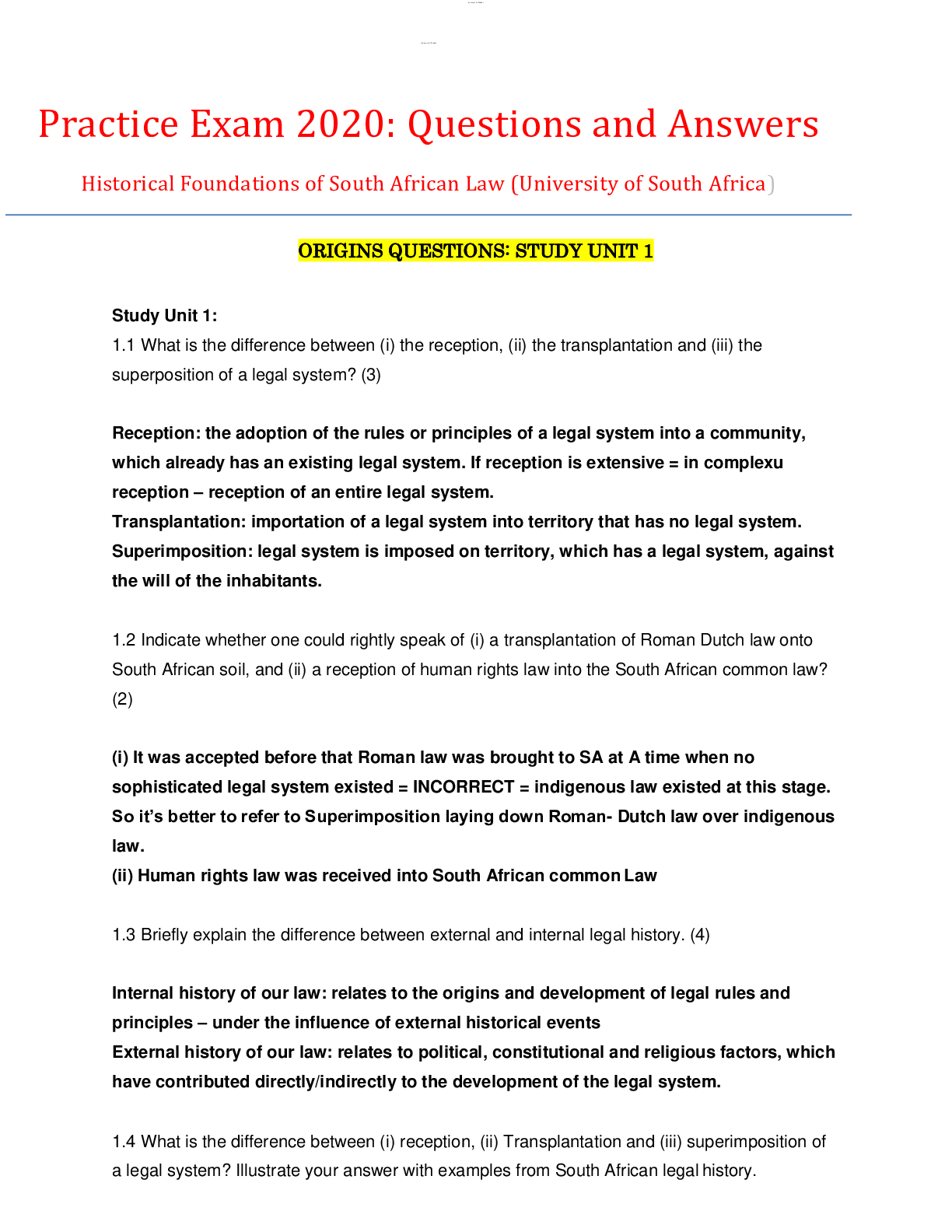
Reviews( 0 )
Recommended For You
Law> Class Notes > Criminal Procedure: CPR3701 Possible examinations questions Criminal Procedure (University of South Africa) (All)

Criminal Procedure: CPR3701 Possible examinations questions Criminal Procedure (University of South Africa)
THE FOLLOWING QUESTIONS ARE SET TO ENABLE YOU TO PREPARE FOR THE EXAMINATIONS. ONCE YOU ARE ABLE TO ANSWER THEM IT MEANS YOU HAVE COVERED EVERY SCOPE OF THE EXAMINATIONS.
By Kirsch , Uploaded: May 12, 2020
$5
Law> Class Notes > Criminal Procedure CPR3701: STUDY NOTES FROM CHAPTERS 12 TO 23 (University of South Africa) (97 PAGES) (All)
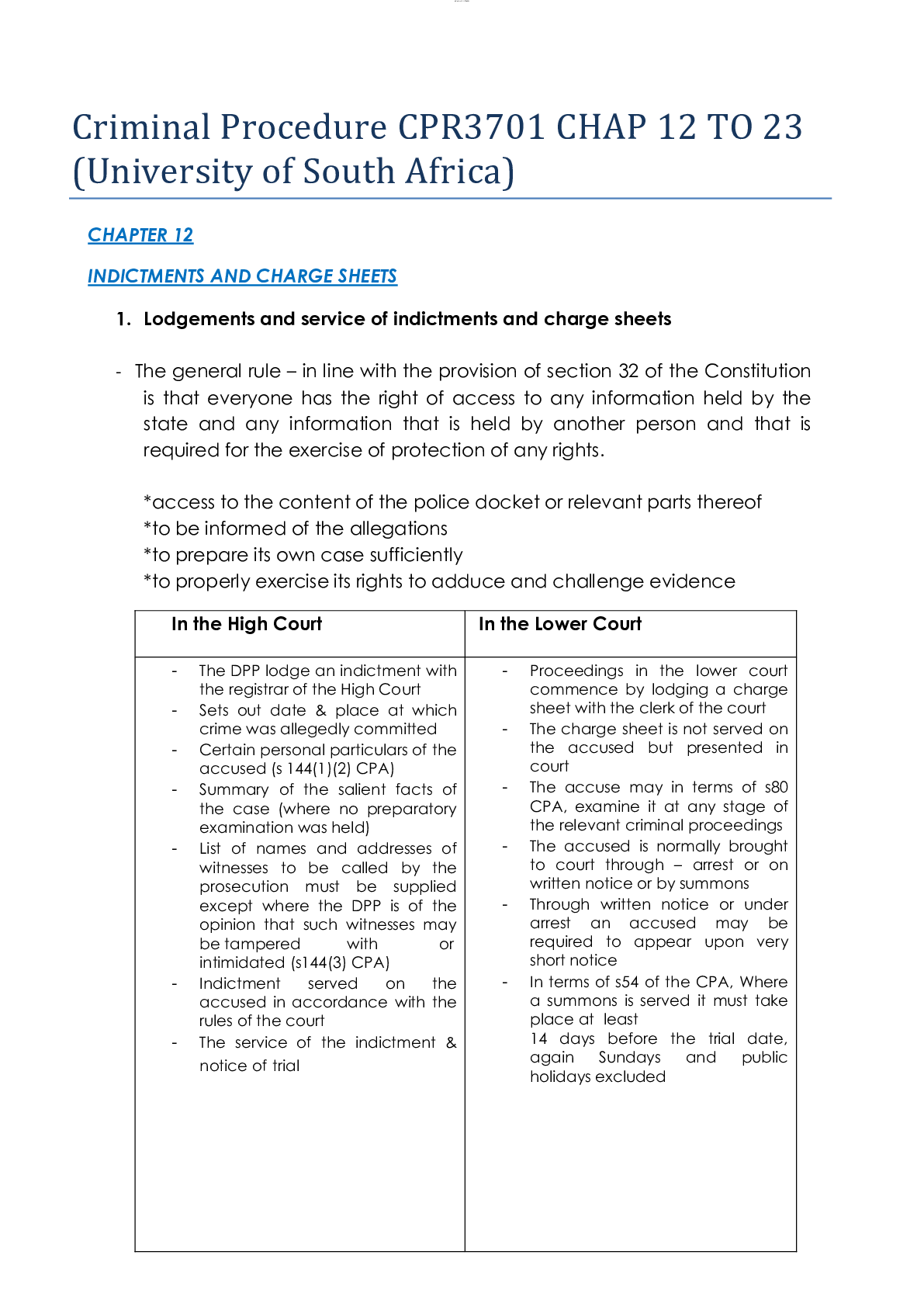
Criminal Procedure CPR3701: STUDY NOTES FROM CHAPTERS 12 TO 23 (University of South Africa) (97 PAGES)
CHAPTER 12 INDICTMENTS AND CHARGE SHEETS CHAPTER 13 THE TRIAL COURTS CHAPTER 14 ARRAIGNMENT AND PLEA OF AN ACCUSED CHAPTER 15 MISCELLANEOUS MATTERS RELATING TO THE TRIAL CHAPTER 16 JOINDER & S...
By Kirsch , Uploaded: May 12, 2020
$8
Accounting> Class Notes > MAC3701 CTM Study Notes Tutoring 2020 Application of Management techniques (University of South Africa) (All)

MAC3701 CTM Study Notes Tutoring 2020 Application of Management techniques (University of South Africa)
STUDY UNIT 1 PLANNING AND CONTROLLING INVENTORY Factors Involved In Inventory Analysis Economic Order Quantity ABC Ltd. is engaged in sale of footballs. Its cost per order is $400 and its carryin...
By Kirsch , Uploaded: May 09, 2020
$12
Finance> Class Notes > FSA Individual Assignment Part 2 & 3- Blackmores (All)

FSA Individual Assignment Part 2 & 3- Blackmores
Executive Summary Blackmores Ltd is an Australian listed (BKL) international supplier of a wide range of vitamins and supplementary dietary products. The company employs over 1000 workers and their...
By Kirsch , Uploaded: Oct 20, 2019
$7
*NURSING> Class Notes > Child Health Nursing. Pediatric ATI Notes (All)

Child Health Nursing. Pediatric ATI Notes
John Pediatric ATI Notes Child Health Nursing Pediatric ATI Notes Chapter 1: Intro • Parenting styles o Authoritarian: my way or the highway o Democratic/authoritative: “v” very good parent...
By SuperSolutions© , Uploaded: Nov 28, 2020
$9.5
*NURSING> Class Notes > NR 566 / NR566 Advanced Pharmacology Care of the Family Week 1 Complete Notes Chapters 21, 33, 41 | Highly Rated | Latest 2020 / 2021 | Chamberlaine College (All)
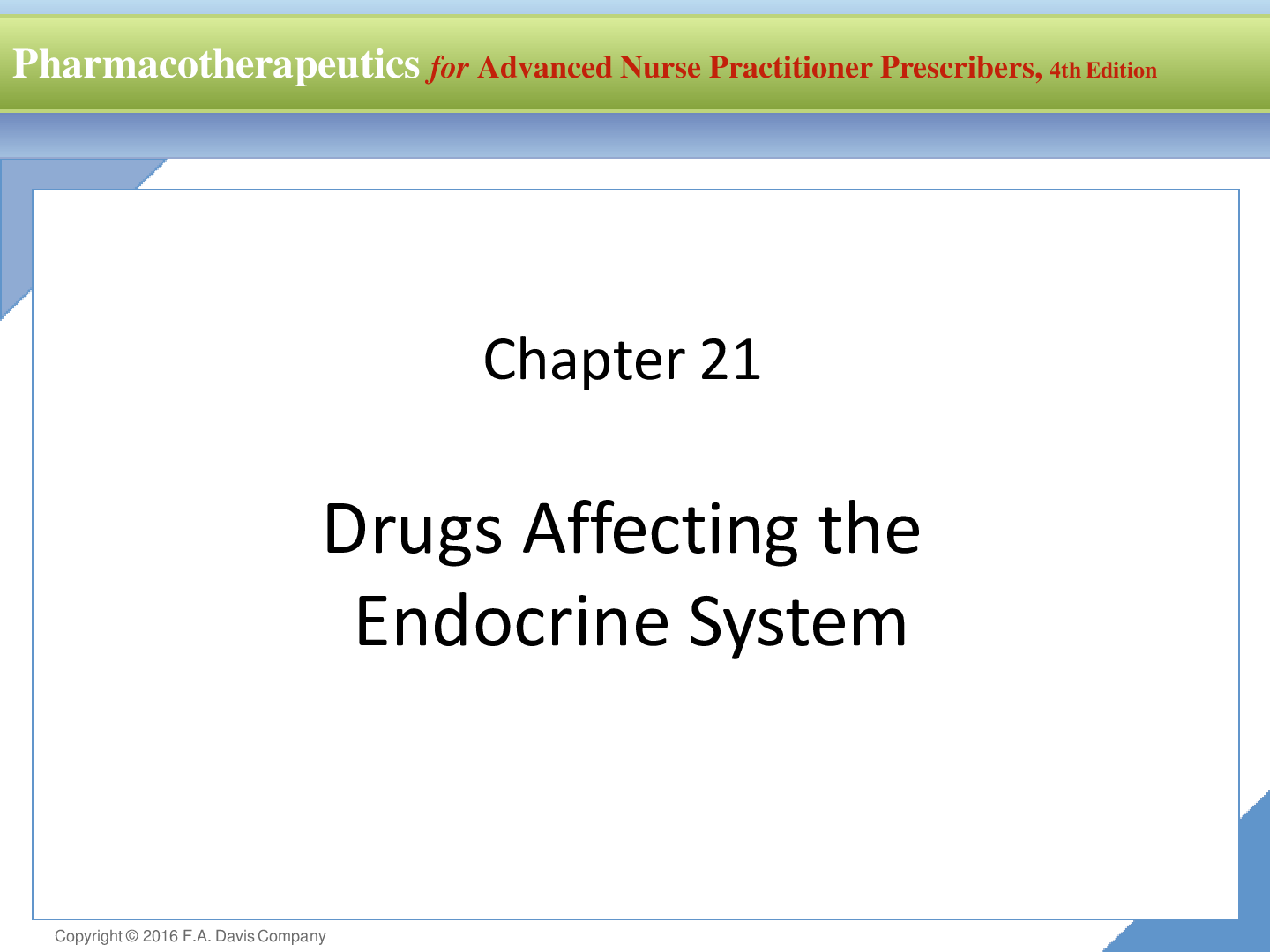
NR 566 / NR566 Advanced Pharmacology Care of the Family Week 1 Complete Notes Chapters 21, 33, 41 | Highly Rated | Latest 2020 / 2021 | Chamberlaine College
Contains NR 566 / NR566 Advanced Pharmacology Care of the Family Week 1 Complete Notes Chapters 21, 33, 41 | Highly Rated | Latest 2020 / 2021 | Chamberlaine College
By nurse_steph , Uploaded: Dec 27, 2020
$10.5
*NURSING> Class Notes > NR 566 / NR566 Advanced Pharmacology Care of the Family Week 2 Notes Chapters 17, 30, 42, 45 | Highly Rated | Latest 2020 / 2021 | Chamberlain College (All)
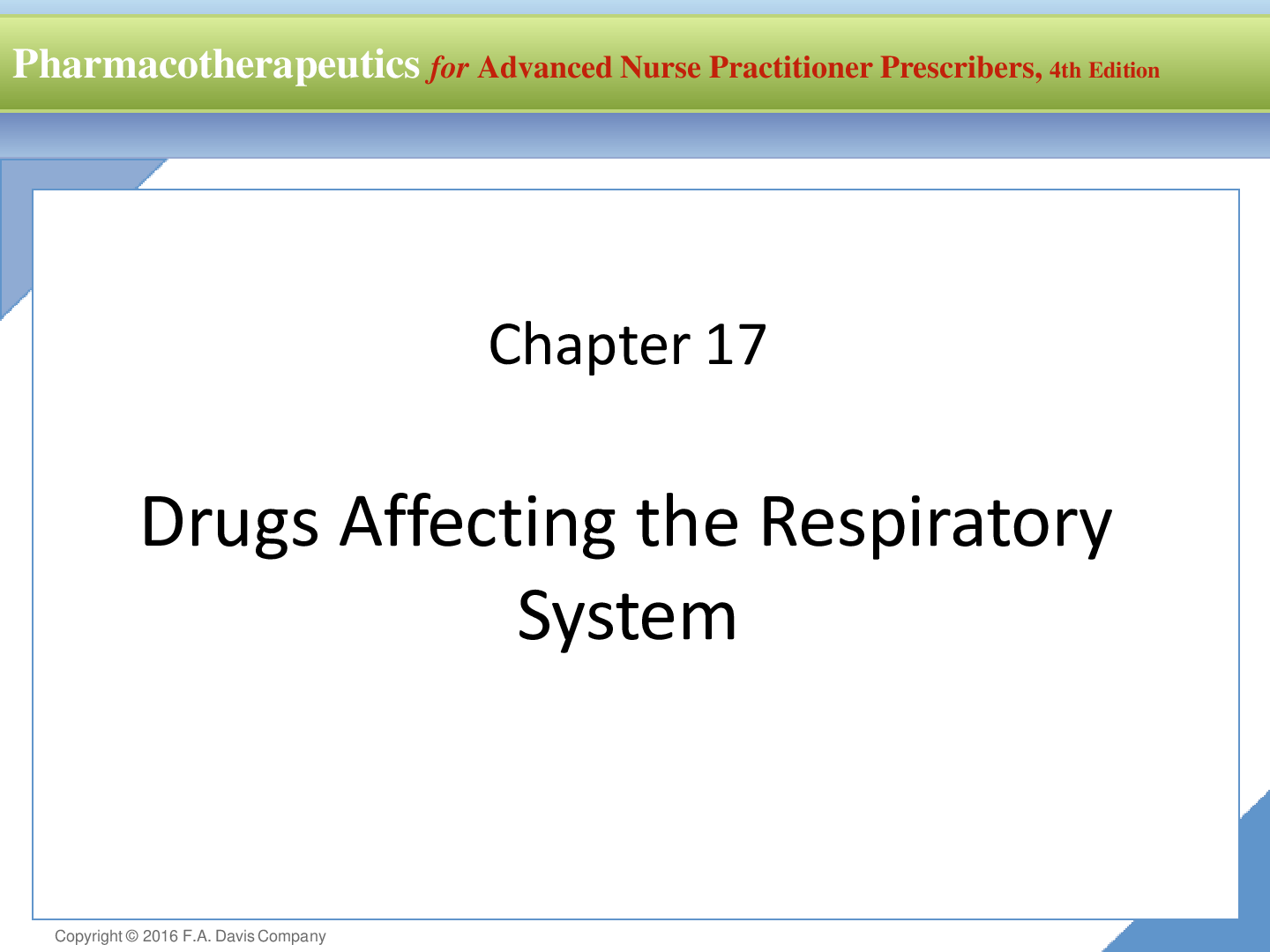
NR 566 / NR566 Advanced Pharmacology Care of the Family Week 2 Notes Chapters 17, 30, 42, 45 | Highly Rated | Latest 2020 / 2021 | Chamberlain College
Conatains NR 566 / NR566 Advanced Pharmacology Care of the Family Week 2 Notes Chapters 17, 30, 42, 45 | Highly Rated | Latest 2020 / 2021 | Chamberlain College
By nurse_steph , Uploaded: Dec 27, 2020
$11
*NURSING> Class Notes > NR 566 / NR566 Advanced Pharmacology Care of the Family Week 4 Complete Notes Chapters 25 | Highly Rated | Latest 2020 / 2021 | Chamberlain College (All)
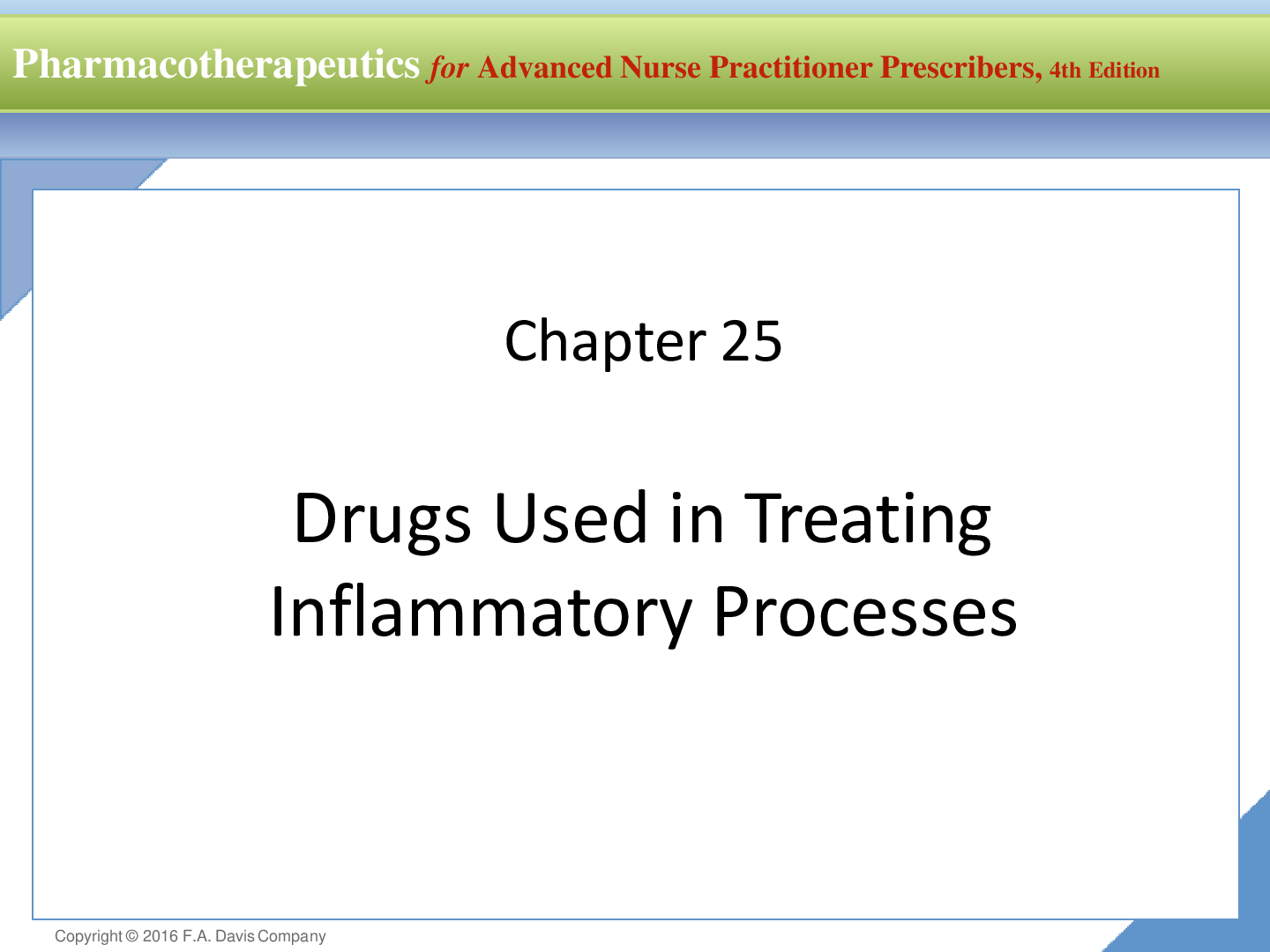
NR 566 / NR566 Advanced Pharmacology Care of the Family Week 4 Complete Notes Chapters 25 | Highly Rated | Latest 2020 / 2021 | Chamberlain College
Contains NR 566 / NR566 Advanced Pharmacology Care of the Family Week 4 Complete Notes Chapters 25 | Highly Rated | Latest 2020 / 2021 | Chamberlain College
By nurse_steph , Uploaded: Dec 27, 2020
$10
*NURSING> Class Notes > NR 566 / NR566 Advanced Pharmacology Care of the Family Week 5 Notes Chapters 18, 27 | Highly Rated | Latest 2020 / 2021 | Chamberlain College (All)
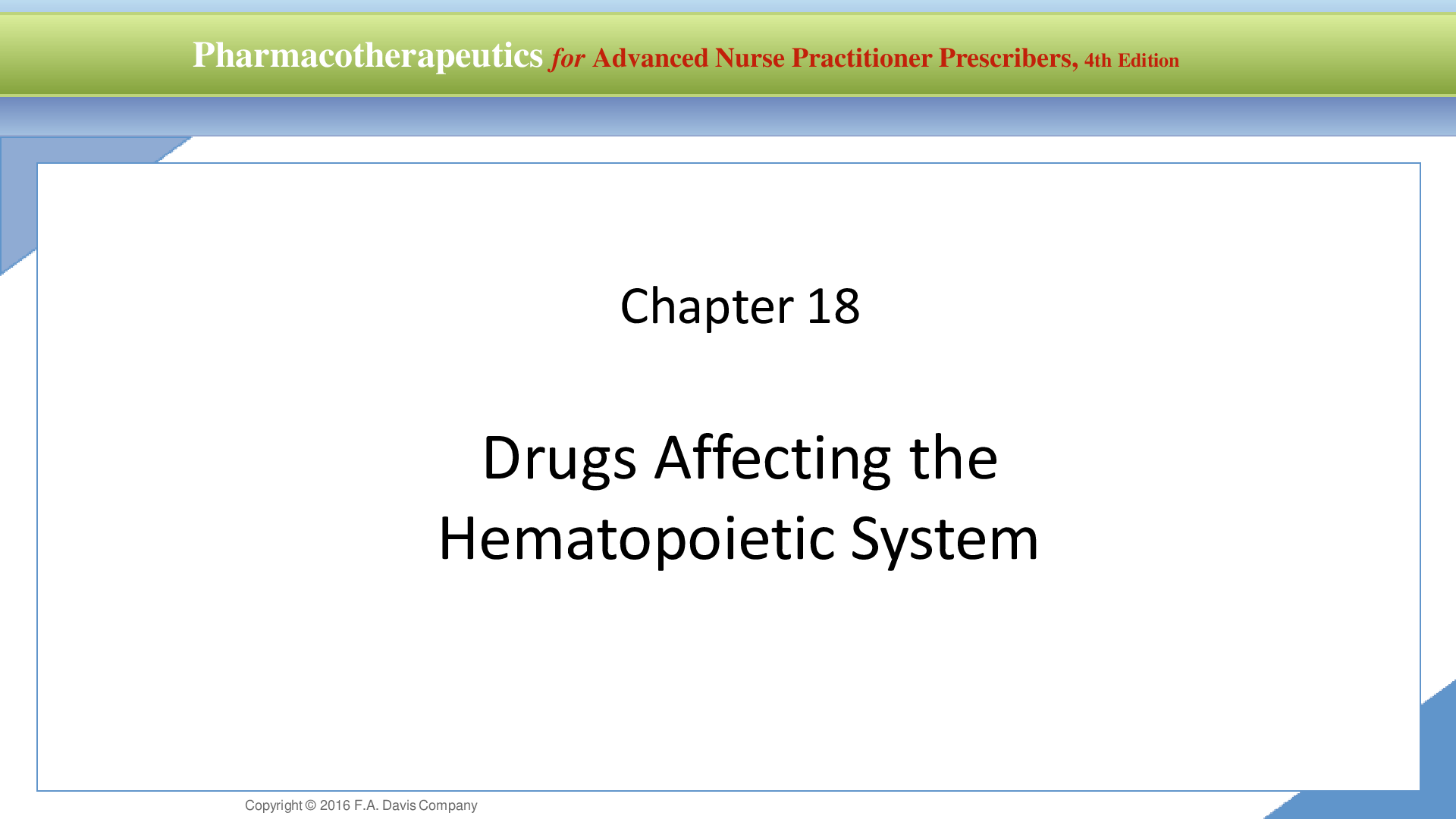
NR 566 / NR566 Advanced Pharmacology Care of the Family Week 5 Notes Chapters 18, 27 | Highly Rated | Latest 2020 / 2021 | Chamberlain College
Contains NR 566 / NR566 Advanced Pharmacology Care of the Family Week 5 Notes Chapters 18, 27 | Highly Rated | Latest 2020 / 2021 | Chamberlain College
By nurse_steph , Uploaded: Dec 27, 2020
$10
*NURSING> Class Notes > NR 566 / NR566 Advanced Pharmacology Care of the Family Weeks 6 Complete Notes Chapters 22, 31, 38, 44 | Highly Rated | Latest 2020 / 2021 | Chamberlain College (All)
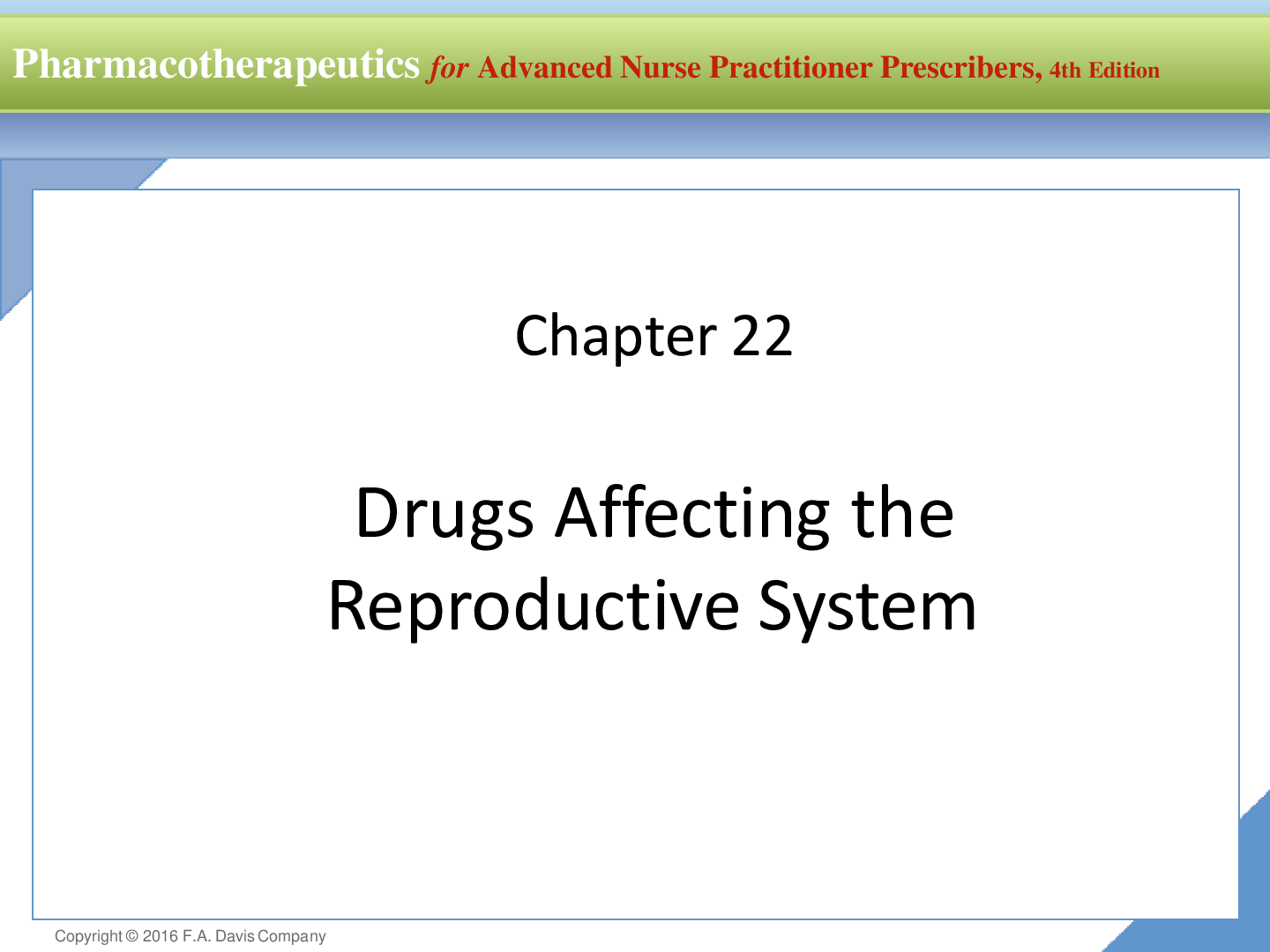
NR 566 / NR566 Advanced Pharmacology Care of the Family Weeks 6 Complete Notes Chapters 22, 31, 38, 44 | Highly Rated | Latest 2020 / 2021 | Chamberlain College
Contains NR 566 / NR566 Advanced Pharmacology Care of the Family Weeks 6 Complete Notes Chapters 22, 31, 38, 44 | Highly Rated | Latest 2020 / 2021 | Chamberlain College
By nurse_steph , Uploaded: Dec 27, 2020
$11.5
Document information
Connected school, study & course
About the document
Uploaded On
Jul 31, 2020
Number of pages
62
Written in
Additional information
This document has been written for:
Uploaded
Jul 31, 2020
Downloads
0
Views
698






